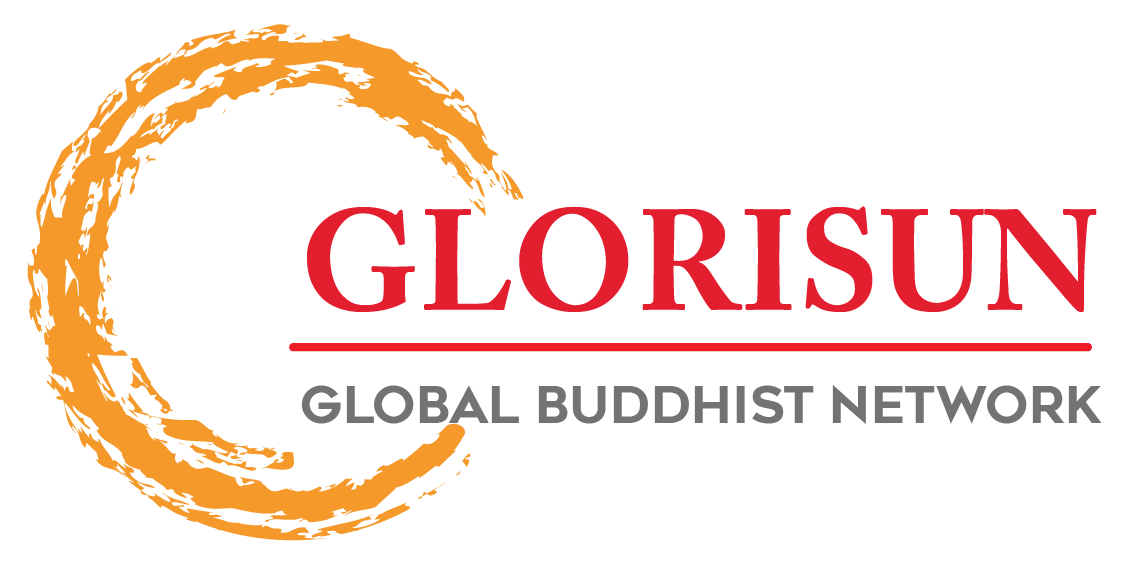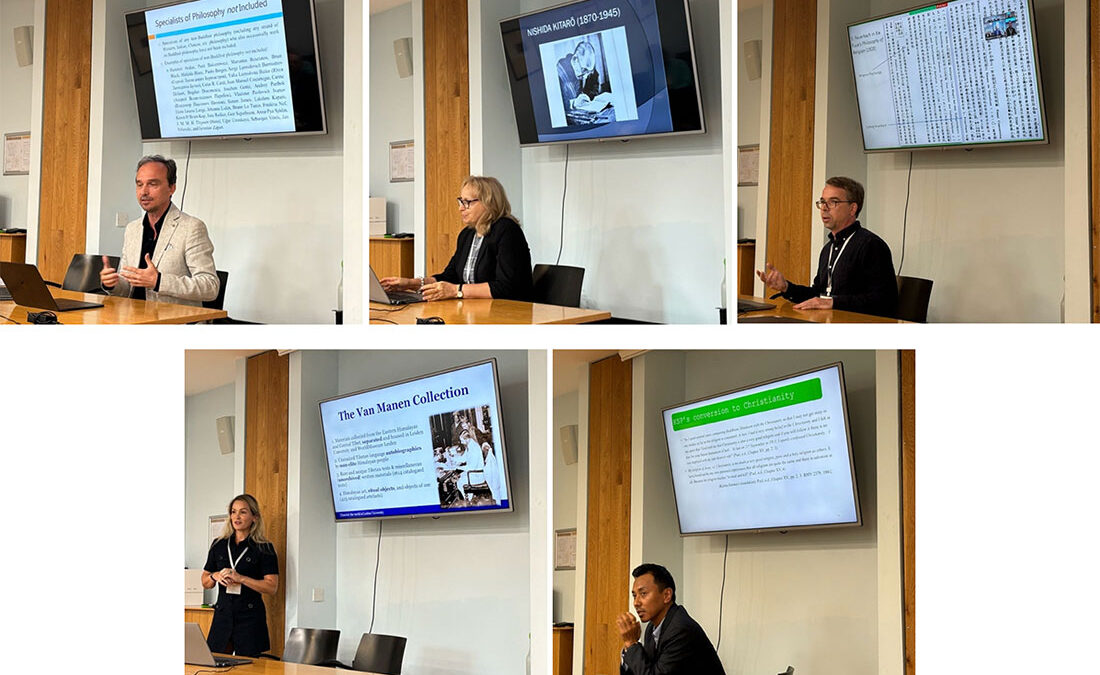Return to the main conference page.
Return to the main reports page.
Posted on
Text by Yizhuo Li, University of Cambridge
Photos by Yizhuo Li and Grace Lee
From August 30 to September 1, 2024, the second Glorisun Annual Forum ‘Beyond Civilizational Clash: The Coalescence of Human Civilizations’ was held at Magdalene College, University of Cambridge, with approximately 60 scholars participating. The forum consisted of an opening ceremony, five keynote speeches, two conferences, and a closing ceremony. The themes of the two conferences were ‘When the Himalayas Encounter the Alps: The Past, Present, and Future of Asia-Europe Buddhist and Other Religious Changes’, and ‘The Healer-King Curing the Three Poisons, while the Master Navigator Overcomes the Nine Misfortunes: An International Conference on Buddhism and Medicine from an Interdisciplinary and Global Historical Perspective’.
This report focuses on the ‘When the Himalayas Encounter the Alps’ conference, which explored the history of religious exchanges in depth, particularly Buddhism between Europe and Asia, analysed the current status of religious interactions, and envisioned future possibilities. The forum attracted scholars from multiple countries who discussed how Buddhism developed and spread across Eurasia and became a crucial bridge for dialogue between Asian and European civilizations.
The ‘When the Himalayas Encounter the Alps’ conference was divided into seven specialized panels: ‘Buddhism in Europe: Philosophical and Psychological Entanglement,’ ‘Buddhism’s Journey to the West, from Sea to Land, from Past to Present,’ ‘Chan/Zen,’ ‘Buddhism-tied Eurasia,’ ‘ Rise of Buddhology in the Europe,’ ‘Central Asia and Mid-East (1),’ and ‘Central Asia and Mid-East (2).’
‘Buddhism in Europe: Philosophical and Psychological Entanglement’
In the first panel, ‘Buddhism in Europe: Philosophical and Psychological Entanglement,’ five scholars presented their papers. The panel was chaired by Georgios T. Halkias (University of Hong Kong), with T. H. Barrett (SOAS, University of London) serving as the discussant.

From top left: Rafal K. Stepien, Agnieszka Kozyra, Richard Ellguth, Berthe Jansen, and Tenzin Tsepak.
First, Rafal K. Stepien (Austrian Academy of Sciences) discussed the place of Buddhism in European philosophy. He pointed out that while philosophical studies are primarily concentrated in university philosophy departments, Buddhist philosophy is almost absent from these institutions. However, there is still a considerable amount of Buddhist philosophy research, although it is mostly conducted in other academic institutions. His report aimed to clarify the misalignment between Buddhism and European philosophy.
Next, Agnieszka Kozyra (University of Warsaw) compared two works by Nishida Kitarō 西田幾多郎, An Inquiry into the Good 善の研究and The Logic of Topos and the Religious Worldview 場所的論理と宗教的世界觀, focusing on their views on Buddhism and Christianity. She analysed the cross-cultural dialogue between Nishida’s thoughts on human nature, ethics, and religious conversion in these two religions, suggesting that Nishida’s ideas could be considered ‘Anonymous Buddhism,’ similar to Karl Rahner’s concept of ‘Anonymous Christianity.’
Richard Ellguth (Free University of Berlin) examined how Chinese Buddhist intellectuals during the Republican period absorbed and integrated Western concepts of religious psychology. He pointed out that through journals like Haichaoyin 海潮音 and Xiandai fojiao 現代佛教, Chinese Buddhist scholars adopted Western ideas like ‘religious feeling’ and ‘mysticism,’ which were not dependent on monotheism, allowing for a new academic dialogue between Buddhism and Christianity.
Berthe Jansen (Leiden University) introduced the Dutch theosophist Johan Van Manen (1877–1943) and his research on Himalayan Buddhism. Van Manen focused on Tibetan Buddhism and local religious practices, collecting a large number of Tibetan texts and artifacts. He played the role of a ‘facilitator of knowledge’ between the Himalayan region and European academia, having a significant impact on the academic study of Himalayan Buddhism.
Finally, Tenzin Tsepak (Leiden University) analysed the experiences of religious conversion in Tibetan autobiographies from the early 20th century. He explored how Tibetans in border towns of the Himalayas interacted with Christianity and other religions, showing how these individuals navigated between different religions without being confined to a single faith, demonstrating the fluidity and flexibility of religious identity.
In summary, this panel showcased the diversity of Buddhism in different cultures and its interactions with other religions and philosophies, providing us with rich academic perspectives.
‘Buddhism’s Journey to the West, from Sea to Land, from Past to Present’
The second panel, titled ‘Buddhism’s Journey to the West, from Sea to Land, from Past to Present,’ was chaired by Hu Xiaodan (Fudan University), with Nelson Landry (University of Hamburg) serving as the discussant. Four scholars presented their research in this panel.
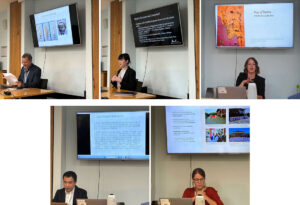
From top left: Georgios T. Halkias, Lin Chia-Wei, Alexandra Kaloyanides, Ji Zhe, and Amandine Péronnet.
First, Georgios T. Halkias (University of Hong Kong) explored the cross-cultural exchanges between Buddhism and Greek and Roman cultures. He emphasised the mutual influences between Greek culture and Buddhism across maritime trade, commercial routes in Eurasia, religious exchanges, and the arts. He argued that this cross-cultural interaction did not lead to the merging of the two traditions but rather deconstructed the boundaries between them, enriching the notion of ‘Graeco-Buddhism’ and demonstrating that Greek and Buddhist cultures were not entirely separate entities throughout history.
Next, Lin Chia-Wei (University of Lausanne) discussed the cross-cultural and cross-linguistic transmission of the Buddhist biography Barlaam and Josaphat. This story travelled from India to medieval Persia, then through Arabic, Georgian, and Greek, eventually reaching Europe. The story’s transmission involved different religions, including Manichaeism, Islam, and Christianity. Lin analysed the translation strategies used during these language transitions and examined the changes in Buddhist terminology and proper names across the languages.
Alexandra Kaloyanides (University of North Carolina at Charlotte) examined how the Southeast Asian river transportation impacted the transmission of Buddhist ideas to Europe during the late 19th and early 20th centuries, focusing on the British-controlled Irrawaddy Flotilla Company. This company not only drove economic changes in Myanmar but also promoted the image of Burmese Buddhism to European tourists. Through the analysis of company archives, passenger memoirs, and Burmese royal correspondence, Kaloyanides explored how Europeans understood Burmese Buddhism and how this understanding compared to contemporary Orientalist views of Buddhism.
Ji Zhe 汲喆 (National Institute of Oriental Languages and Civilizations (Inalco)) reviewed the history and development of Chinese Buddhist studies in France, highlighting France’s pioneering role in the Western study of Chinese Buddhism. He pointed out that France’s strong humanities tradition, elite academic system, and continuity in research over the past two centuries have built a solid foundation for this academic tradition. He thoroughly analysed the different paradigms and disciplinary structures of French Buddhist studies at various times and demonstrated France’s influence in advancing Buddhist research.
Amandine Péronnet (Inalco) focused on the development of Chinese Buddhist academies in the 20th century, particularly how these academies trained religious professionals to meet official demands. Using Mount Wutai Buddhist Academy for Nuns (Wutaishan nizhong foxueyuan 五台山尼眾佛學院) as a case study, her research revealed the interest of Chinese Buddhist academies in other educational models and their potential dialogue with European academic traditions in educational methodologies.
In conclusion, this panel showcased the cross-cultural exchanges and transmission of Buddhism across different cultures, languages, and historical contexts, demonstrating Buddhism’s diverse development within the global context.
‘Chan/Zen’
The third panel ‘Chan/Zen’ was chaired by Berthe Jansen, with Rafal K. Stepien serving as the discussant.

From left: Przemysław Skrzyński, Norihisa Baba, and Antoine Cid.
Przemysław Skrzyński (Jagiellonian University) presented on the formation of Polish Zen Buddhism, exploring the interactions between religion and politics behind the Iron Curtain.
Norihisa Baba 馬場 紀寿 (University of Tokyo) discussed how Japanese monk Shaku Sōen 釋宗演 became acquainted with the founder of the Pali Text Society, Thomas William Rhys Davids. During his stay in Ceylon from 1887 to 1889, Shaku Sōen was inspired by Rhys and became dedicated to spreading Buddhism to the West. He later sent disciples to the United States, thereby fostering the exchange between East Asian Buddhism and Western academia.
Antoine Cid (Inalco) focused on the correspondence between early 20th-century Chinese poet-monk Su Manshu 蘇曼殊 and Western missionary Rev. Lopez. These letters showcased the dynamic process of intellectual and cultural exchange between China and the West, reflecting the deeper significance of cross-cultural dialogue at the time.
These three scholars approached the topic from different angles, exploring the exchanges and dissemination of Buddhism between Eastern and Western cultures, revealing the complex interactions among religion, politics, and culture.
‘Buddhism-tied Eurasia’
The fourth panel, titled ‘Buddhism-tied Eurasia,’ was chaired by Kyong-Kon Kim (University of Strasbourg), with commentary by Eugene Wang (Harvard University).

From left: Yin Zhao (presenting on behalf of Zhan Ru), Wang Qian and Wang Jingbo.
First, Zhan Ru 湛如 (Peking University) explored the historical significance of Buddhism as a bridge between Chinese and European cultures. He pointed out that the Eurasian continent is the birthplace of many ancient civilizations and has long been a key area for cultural exchanges. Buddhism, as a religion of Indo-European civilization, has a natural connection with European culture. Zhan Ru emphasised that through the platform of Chinese Buddhism 漢傳佛教, cultural and religious interactions between China and Europe can be strengthened, which also has the potential to promote Sino-American relations and world peace.
Li Ling 李翎 (Sichuan University) demonstrated examples of early Eurasian cultural exchanges through the technology of Buddhist statue production. She noted that the earliest Buddhist statues appeared in India from the second century onward. With the frequent commercial and trade exchanges, the influence of foreign merchants on Buddhism prompted monks to change the design of Buddhist relics, leading to narrative carvings focused on Buddha’s stories. Li Ling emphasised that these statues reflect cultural exchanges, especially the impact of Alexander the Great and Hellenistic civilization on Buddhist art.
Wang Qian 王倩 (Zhengzhou University) analysed the origin and evolution of four-armed deities during the Northern Dynasties. She pointed out that although these statues had originated in India, these statues later evolved in two stages: early on, they were primarily depicted as Buddhist guardian deities; later on, as Zoroastrianism 祆教 beliefs entered China during the Northern Dynasties, the four-armed deity statues changed in both appearance and function, reflecting the process of cultural and religious exchange.
Finally, Wang Jingbo 王晶波 (Hangzhou Normal University) discussed the spread of Buddhist birth stories 佛本生故事 in Dunhuang manuscripts. She noted that Dunhuang, as a key hub on the Silk Road, preserved many documents recording Sino-Western cultural exchanges. One such Buddhist birth story circulated widely across Eurasia and was influenced by other cultural elements, including ancient Egyptian mythology. This demonstrates how folk stories evolved in the process of civilizational exchange.
This panel showcased the important role Buddhism played in Eurasian cultural exchanges, from the production of Buddhist statues to the evolution of deity images and the transmission of folk stories. The speakers revealed the rich history of interactions between Buddhism and other cultures and religions.
‘Rise of Buddhology in the Europe’
The following day, the fifth panel, titled ‘Rise of Buddhology in the Europe,’ was chaired by Agnieszka Kozyra, with Elisabeth J. Harris (University of Birmingham) serving as the discussant. Four scholars delivered presentations.

From left: Nelson Landry, Kyong-Kon Kim, and Matthew King.
Li Xuetao 李雪濤 (Beijing Foreign Studies University) introduced the German scholar Johannes Nobel (1887–1960) and his 1927 German translation of the Biography of Kumārajīva 鳩摩羅什傳. Li had conducted a systematic study of Nobel’s life and showed that Nobel had initially studied Indology but later focused on Buddhist studies, learning both Chinese and Tibetan. Nobel’s German translation of Biography of Kumārajīva was groundbreaking for it accurately restored personal names, place names, and book titles, making this piece an indispensable contribution to Indology.
Next, Nelson Landry (University of Hamburg) discussed the misunderstandings and misinterpretations in Western academia regarding the term ‘miracle’ 神異 in Buddhism. Western scholars like Schopenhauer considered Buddhism a rational religion, ignoring its supernatural elements, such as miracle stories and relic worship. To align with Western rationalism, scholars reconstructed an ‘original’ Buddhism, removing the folk religious elements. Landry provided an in-depth analysis of the history of the miraculous and the supernatural in Western academia and addressed the translation issues of ‘miracle’ as a cross-cultural concept.
Kyong-Kon Kim 金慶坤 (University of Strasbourg) focused on the linguistic and historical studies of Buddhism by the 19th-century French scholar Eugène Burnouf (1801–1852). Burnouf’s scholarly methods significantly impacted the development of Buddhist studies in France and Europe.
Matthew King ( University of California, Riverside) explored how the French scholar Jean-Pierre Abel-Rémusat (1788–1832) reconstructed the concept of ‘Buddhist Asia’ through his studies of Qing Inner Asian languages and culture. King analysed how Abel-Rémusat drew inspiration from Qing court quadrilingual dictionaries, transforming Inner Asian Buddhist scholarship and Qing imperial forms into a foundation for Western academic research, establishing the modern framework for Buddhist studies.
These speakers’ presentations covered the development of Buddhist studies in both Chinese and Western academic circles, highlighting key contributions and challenges in cultural and academic exchanges.
‘Central Asia and Mid-East (1)’
The sixth panel, ‘Central Asia and Mid-East (1).’ was chaired by Amandine Péronnet, with Lin Chia-Wei and Liu Yi serving as discussants.
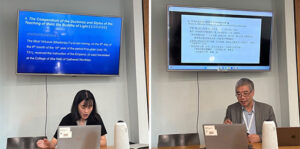
From left: Hu Xiaodan and Chen Jinhua.
Hu Xiaodan 胡曉丹 (Fudan University) explored the different representations of the term ‘Buddha’ 佛in Manichaean texts written in Middle Iranian and Chinese. As a world religion with cross-cultural missionary efforts, Manichaean scriptures exhibit diverse linguistic expressions. In Middle Iranian texts, the term ‘Buddha’ appears infrequently, while in the Chinese texts, especially in the Dunhuang Hymnscroll 下部贊, ‘Buddha’ became a frequently used divine name. Through comparative research, Hu revealed the different understandings of the concept of ‘Buddha’ between Iranian-speaking and Chinese-speaking Manichaeans.
Chen Jinhua 陳金華 (University of British Columbia) focused on the complex life of Zhiyan 智儼/智嚴, a hostage prince from Khotan during the Tang dynasty, discussing his roles as a Buddhist translator and Chan master. Chen pointed out that Zhiyan might be the monk recorded in the Song Gaoseng Zhuan 宋高僧傳 (Biographies of Eminent Monks Compiled under the Song dynasty), whose secular name was Yuchi Le 尉遲樂, and was once a hostage prince of Khotan who later took monastic vows by imperial decree and became an important translator. By reconstructing the life of this historical figure, Chen highlighted the cosmopolitan nature of Buddhism in the Tang dynasty.
These two presentations revealed the important role of Buddhism in the cultural exchanges between Central Asia and China, showcasing the complex historical background of Buddhist translation and thought transmission.
‘Central Asia and Mid-East (2)’
The final panel was chaired by Alexandra Kaloyanides, with Ni Nan and Liu Yi as discussants.

From left: Liu Yi, Sun Yinggang, and Ni Nan.
Liu Yi 劉屹 (Capital Normal University) discussed the issue of ‘blocked routes to Jibin’ (罽賓路梗) as mentioned in the Biography of Sengbiao 僧表傳. The traditional view attributed Sengbiao’s inability to travel to Jibin due to warfare caused by the Hephthalite invasions. However, Liu proposed that the actual reason might have been an earthquake that blocked the road through the Pamir Plateau leading to the Indus Valley. By analysing the westward routes taken by Chinese monks of the time, Liu Yi concluded that Sengbiao abandoned his journey due to the earthquake, and further discussed the transportation routes from the Western Regions to Jibin and the exact location of Jibin.
Sun Yinggang 孫英剛 (Zhejiang University) explored the significance of Kāpiśa 迦必試 in medieval Chinese Buddhism. He analysed Kāpiśa’s role in the transmission of Buddhism, especially its importance in the interactions between Chinese Buddhist monks and the Western Regions.
Ni Nan 倪楠 (SOAS, University of London) focused on the multilingual transmission of the Amoghapāśa-hṛdaya Dhāraṇī 不空羂索心陀羅尼, particularly within medieval China and its surrounding areas. She analysed how this text, first translated into Chinese in 587 AD, was disseminated across China, Tibet, Sogdiana, and the Western Xia region for approximately 800 years. Ni provided a detailed study of the variations in the translation of Buddhist texts across different cultural contexts, using philological methods to investigate the transmission and worship of this dhāraṇī in Dunhuang and Ningxia.
These three presentations covered the transportation routes, cultural exchanges, and textual transmission of Buddhism between China and the Western Regions, offering valuable historical and textual perspectives.
Conclusion
This forum showcased the rich history of Buddhist and religious exchanges between Asia and Europe, providing new perspectives and directions for future academic cooperation. The topics in the ‘When the Himalayas Encounter the Alps’ conference ranged from Buddhism’s influence on European philosophy, dialogues between Buddhist and Christian worldviews, to the formation of Polish Zen Buddhism and the historical significance of Buddhism as a cultural bridge between Europe and Asia. Scholars shared their in-depth research on Buddhist transmission, Buddhist art, and philosophy, offering new insights and understanding into Buddhism’s global development.
Keynote Speeches (1 September)
The keynote speeches on September 1, 2024, were hosted by Ji Zhe (Inalco). Three scholars discussed the historical and cultural exchanges of Buddhism, delving into the complexities of Orientalism, cross-cultural imagination, and Buddhist healing practices.
First, Elizabeth J. Harris (University of Birmingham) presented on the topic of ‘The Complexities of Orientalism: The Case Study of William Knighton.’ She introduced the contributions of the 19th-century Orientalist William Knighton (d. 1900). His writings not only documented Buddhism but also critiqued missionary perspectives, contributing to the modernization of the portrayal of Buddhism in Britain. Harris emphasised that Knighton’s life and works reflect the internal debates within Orientalism, influencing how Buddhism was understood and assimilated by both the British elite and the public.
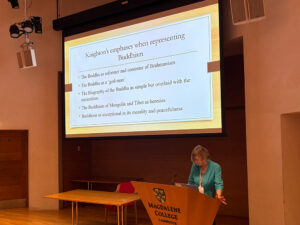
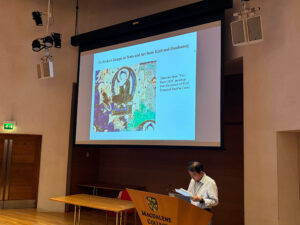
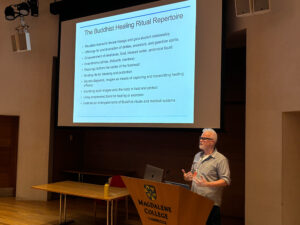
Closing Ceremony
At the closing ceremony of the 2024 second Glorisun Annual Forum, scholars from many world-renowned universities delivered speeches, marking a successful conclusion to the event. First, Noga Ganany (University of Cambridge), representing the host institution, delivered an in-person speech. Ganany expressed sincere congratulations on the successful organisation of the forum, extended gratitude to the Glorisun International Buddhist Studies Network, and highly praised the achievements in promoting academic exchange and cross-cultural dialogue at this event.
Following this, speeches were delivered by Andrew Skilton (University of Oxford), Eugene Wang (Harvard University), and Eric Greene (Yale University) via video. They introduced the Buddhist studies activities carried out at their respective institutions with the support of the Glorisun Network, and emphasised that international cooperation among scholars would have profound impacts on the further development of the field.
Ji Zhe (Inalco), representing the host of the third Glorisun Annual Forum, also delivered a speech. He acknowledged the accomplishments of the current forum, thanked the Glorisun Network for its support of Buddhist studies, and expressed his anticipation for the next forum in Paris, which he hoped would continue to advance the depth and breadth of academic research.
The event concluded with a summary speech by Chen Jinhua (University of British Columbia). In his summary, Chen expressed gratitude to all participants and highly praised the achievements of this year’s forum. He noted that the forum not only fostered interdisciplinary academic exchange but also created a broader platform for dialogue within the global academic community.
Text by Yizhuo Li, University of Cambridge
Photos by Yizhuo Li and Grace Lee
